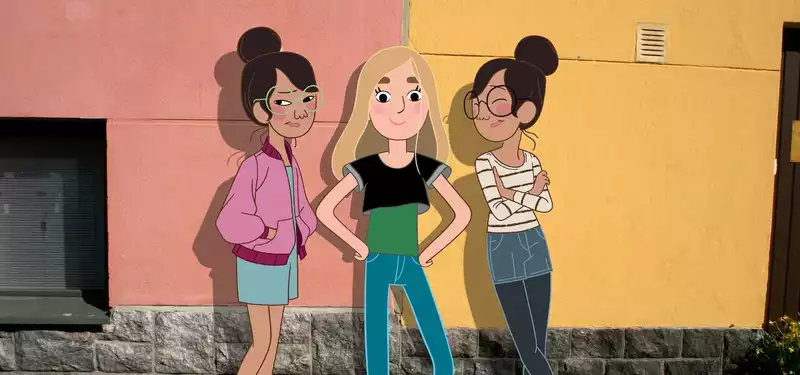Apr 6, 2020
The Royals Next Door" Breaks New Ground in Finnish (and European) Animation
When you hear the word "Finnish animation," you probably think of one of the many franchises. Angry Birds, or Moomin Valley, or maybe Gigglebug. If Pablo Jordi is so inclined, this could change very soon.
While Finland has a sophisticated technology and gaming scene, its animation industry is just beginning to mature. As evidence, the Nordic country is beginning to produce original series with global ambitions: in February, we reported on Nickelodeon International's "Best & Bestor," a series of animated films that were produced in the country's capital of Helsinki, Finland. And now there is "Royals Next Door" from Jordi's Pikkala Studios in Helsinki. This show has just gone into production.
The royals in the title are a fictional European monarchy forced to leave their castle and move to a normal neighborhood. The show follows the adventures of the family, especially teenage Princess Stella, as she tries to adjust to normal life.
"The Royals Next Door" was the brainchild of Finnish filmmaker and Pikkala co-founder Veronika Lassenius. She directed the series and produced it with her longtime creative partner Jordi. The two co-produced the children's shows "Saari" and "Fungi" in Jordi's native Spain before moving to Finland and launching Pikkukala in 2012. He then opened a sister studio in Barcelona, where he is currently co-producing the series Stinky Dog for Folivari.
In other words, they were a trans-European team from the beginning. However, "The Royals Next Door" is a four-country co-production and the first project led by a Finnish producer. The series involves broadcasters and studios from Finland, Spain, Flanders (Belgium), and Ireland.
The project will be creatively led by Lassenius in Helsinki, where compositing, post-production, and sound will also take place. Pre-production will take place at Pikkala's Barcelona studio. Animation is by Lunanime in Flanders. The program consists of 2D animation with live action and photographic backgrounds shot in Ireland. The scriptwriters are spread across Finland, Spain, Ireland, and the UK and are coordinated by e-mail and video conferencing.
While this particular combination of countries may be unusual, international co-productions are common in Europe, and successful animation projects often require a patchwork of funding from various sources.
In the case of Finland, the relative lack of local talent and problems with the funding system provide extra incentives to look abroad. However, according to Jordi, the situation is better than when he first set up store in 2012. Below, Jordi talks about the changing fortunes of the domestic animation industry and his hopes for the future:
Jordi: Before, most independent productions were at best targeting the domestic or Scandinavian market. Local talent had to go abroad to participate in internationally interesting projects, and producers found it difficult to raise money for larger projects due to the lack of financial support. Social recognition was also lacking. The average person on the street understood the value of the mobile gaming industry more than the animation industry.
Rovio's Angry Birds Toons series (which I was fortunate enough to have the opportunity to produce several seasons of) was a turning point for the industry. It brought in international talent and nurtured local talent to create a unique studio in Scandinavia that produced highly successful, production-worthy animation worldwide. Even if the studios are no longer around, their influence can still be felt today. Most Finnish animation companies have benefited from the studio in one way or another.
Over time, the animation scene has evolved, funding sources have increased, and public understanding has grown. Still, it can be difficult for an independent producer to make a project successful.
We need to continually educate our institutions on the value of the animation industry. The audiovisual incentives (up to 25%) instituted several years ago are very important for animation producers, but they were designed with live-action services in mind and have important design shortfalls with regard to original animation production.
The shortage of artists is something we have to face. Labor is more expensive than in Southern Europe and the talent pool is smaller. This is also the case in other Nordic countries. A curious phenomenon is that good senior animators often end up working full time in mobile games. Increased cooperation with other Nordic countries could address this problem. Political measures could stimulate the circulation of artists in the Nordic region.
A shortage of talent is often a problem in Finland, but not everything is black and white. Being based in Finland and Spain allows us to be flexible. For example, we sent two talented Finnish animators to Pikkala Barcelona for the production of Stinky Dog. Interestingly, while Belgium is a more mature industry (than Finland), we have also found it difficult to find talent when there are many film and TV projects going on at the same time.
The Covid-19 crisis affected our main location plans and forced us to postpone them. This is not the only challenge the crisis has posed to us, and given that this is an international production, we expect many more. We are accustomed to working remotely, which works to our advantage in these situations.
Collaboration between the EU is creatively very rewarding. It is also a way to establish a European animation identity and to face together some of the challenges on our continent, such as leveling the playing field between nations and addressing the precarious working conditions of animation professionals. Our ambition is that "The Royals Next Door" will become a success story and pave the way for other Finnish producers to enter this co-production circuit.
"The Royals Next Door" will air in January 2021. Jordi's comments were taken from a lengthy response sent via email.
.



Post your comment